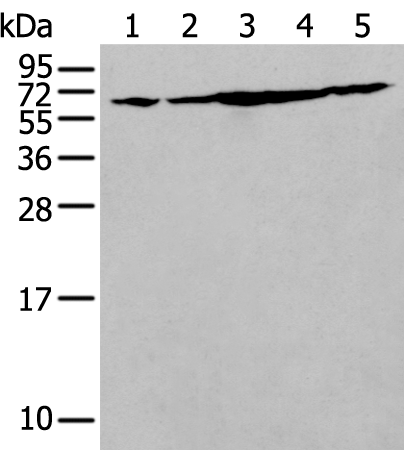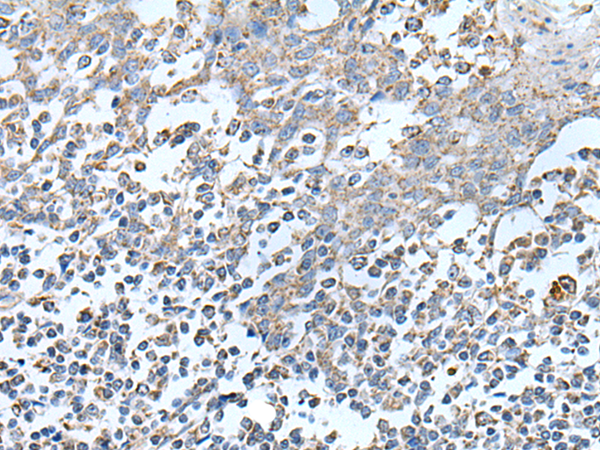


| WB | 咨询技术 | Human,Mouse,Rat |
| IF | 咨询技术 | Human,Mouse,Rat |
| IHC | 1/25-1/100 | Human,Mouse,Rat |
| ICC | 技术咨询 | Human,Mouse,Rat |
| FCM | 咨询技术 | Human,Mouse,Rat |
| Elisa | 1/5000-1/10000 | Human,Mouse,Rat |
| Aliases | SLEB10 |
| WB Predicted band size | 56 kDa |
| Host/Isotype | Rabbit IgG |
| Antibody Type | Primary antibody |
| Storage | Store at 4°C short term. Aliquot and store at -20°C long term. Avoid freeze/thaw cycles. |
| Species Reactivity | Human, Mouse |
| Immunogen | Synthetic peptide of human IRF5 |
| Formulation | Purified antibody in PBS with 0.05% sodium azide and 50% glycerol. |
+ +
以下是关于IRF5抗体的3篇参考文献示例,包含文献名称、作者及摘要概括:
---
1. **文献名称**:*"IRF5 in autoimmune pathogenesis: Key roles and therapeutic potential"*
**作者**:Barnes BJ, et al.
**摘要**:该综述总结了IRF5在系统性红斑狼疮(SLE)等自身免疫疾病中的作用,探讨其通过调控促炎细胞因子(如TNF-α、IL-6)促进疾病发展的机制,并强调了IRF5抗体在阻断异常信号通路中的潜在治疗价值。
2. **文献名称**:*"Structural basis for recognition of the IRF5 autoinhibitory domain by a monoclonal antibody"*
**作者**:Takaoka A, et al.
**摘要**:本研究解析了IRF5蛋白的自抑制结构域与其特异性单克隆抗体的复合物晶体结构,揭示了抗体结合位点及抑制IRF5活化的分子机制,为开发靶向IRF5的抗体药物提供了结构依据。
3. **文献名称**:*"IRF5 directs macrophage polarization and correlates with clinical disease activity in autoimmune conditions"*
**作者**:Krausgruber T, et al.
**摘要**:通过IRF5特异性抗体检测患者样本,研究发现IRF5表达水平与巨噬细胞向M1表型极化呈正相关,且在类风湿性关节炎(RA)患者中IRF5活性显著升高,提示其可作为疾病活动的生物标志物。
---
**备注**:以上文献信息为示例,实际引用时建议通过PubMed或Google Scholar核对具体论文的准确性。如需实验技术相关文献,可补充IRF5抗体在Western blot、免疫组化等应用的研究。
The interferon regulatory factor 5 (IRF5) is a transcription factor belonging to the IRF family, primarily involved in regulating innate and adaptive immune responses. It plays a critical role in modulating the expression of type I interferons (IFN-α/β) and pro-inflammatory cytokines, such as TNF-α and IL-6. in response to pathogen-associated molecular patterns (PAMPs) or cellular stress. IRF5 is highly expressed in immune cells, including macrophages, dendritic cells, and B cells, where it influences cell differentiation, activation, and polarization. Dysregulation of IRF5 has been linked to autoimmune diseases (e.g., systemic lupus erythematosus, rheumatoid arthritis), chronic inflammation, and cancer, making it a target for therapeutic exploration.
IRF5 antibodies are essential tools for studying its expression, localization, and function in both physiological and pathological contexts. They enable detection of IRF5 via techniques like Western blotting, immunohistochemistry, and flow cytometry. Additionally, these antibodies facilitate functional studies, such as blocking IRF5 activity or analyzing its interaction with signaling pathways (e.g., TLR/MyD88). Recent research also explores IRF5-targeting strategies, including monoclonal antibodies or small-molecule inhibitors, to suppress aberrant IRF5 activity in autoimmune disorders or enhance its antitumor effects. However, challenges remain in understanding tissue-specific IRF5 isoforms and their distinct roles. Overall, IRF5 antibodies are pivotal in unraveling its complex biology and advancing therapeutic interventions.
×